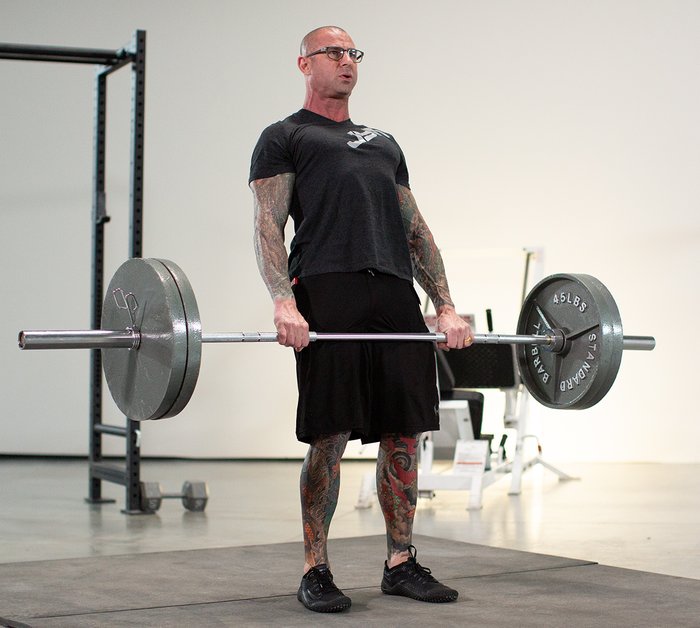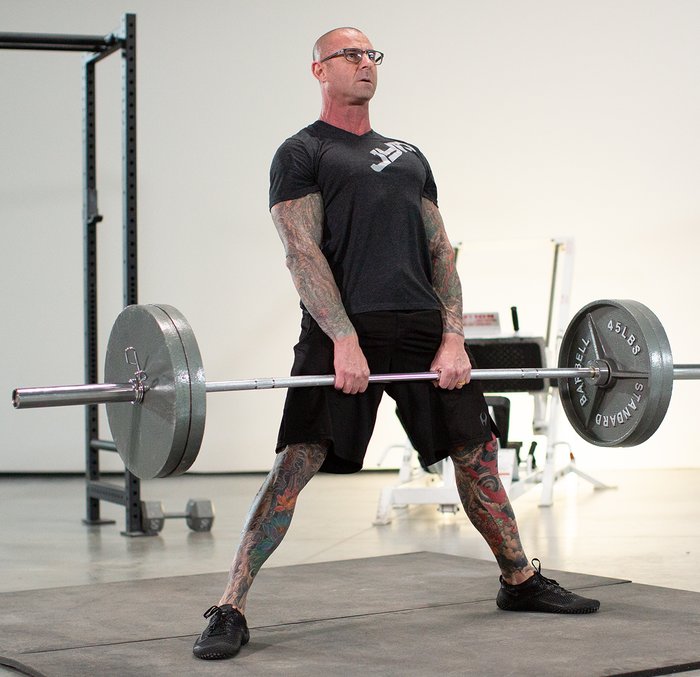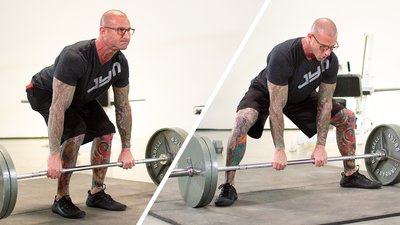With a doctorate in physiology, post-doctoral research at Yale, and an encyclopedia of muscle and strength to his name, Jim Stoppani, Ph.D., is someone to pay attention to when you want to learn how to do an exercise correctly. And what better exercise to master than the deadlift?
As Stoppani says, the deadlift is considered the ultimate test of overall body strength—a combination of both a push, with the legs doing the pushing, and a pull, with the upper body doing the pulling. While it may seem like a simple exercise in which you merely lift a barbell off the floor, done improperly, you can end up not only exercising the wrong muscles, but exposing yourself to injury.
Two popular deadlift variations are the conventional and the sumo. Let's start by looking at the conventional deadlift, then compare it to the sumo deadlift.
Conventional Deadlift Setup
The first step in mastering the conventional deadlift is assuming the proper stance. As you approach the bar, position yourself so that your feet are about hip-distance apart, your toes are pointed forward, and your shins are very close to the bar.
When you lift, you will essentially drag the weight up your shins, keeping the barbell close to your body the whole way up. Keeping the bar close prevents your center of gravity from shifting too far forward. Keeping the center of gravity back is important not only for protecting your back, but also for maximizing the amount of weight you can lift.
With your feet in the proper position and your shins against the bar, grab the barbell at about a shoulder-width distance. You can use the staggered grip, with one hand in an overhand grip and the other in an underhand grip, or you can use two overhand grips. For most people, using the underhand grip can put added stress on the forearm. When you're going heavy, that can lead to forearm injury.

Conventional Deadlift Movement Pattern
Once you have your hands on the barbell, drop down until your thighs are almost parallel to the floor. Unlike when you're squatting, your thighs don't need to be completely parallel—just above parallel is fine. Be sure to keep your back flat by maximizing the arch in your lumbar spine. Do not round your back, which can lead to injuries. Get a natural curve in your spine by sticking out your butt, keeping your chest high, and placing your weight back on your heels.
As you pull up the bar, don't try to lift straight up. Let the barbell come back toward you to help maintain your center of gravity.
Sumo Deadlift Setup
This version of the deadlift is called "sumo" because it mimics the position a sumo wrestler assumes before a bout.
The main difference between the sumo and the conventional deadlift is the position of the feet and hands. Instead of being about hip-width apart, with sumo the feet are positioned wider than your hands. How wide apart they are depends on your height, but they will be much farther apart than shoulder width. With your feet spread so far apart, your hands will want to grab the bar closer together than in a conventional deadlift, typically at about shoulder width. As with the conventional deadlift, use a staggered or overhand grip; it's up to you. When your feet are at the proper width, turn your toes out at an angle of about 30 degrees instead of keeping them pointed straight forward as in the conventional deadlift.

Sumo Deadlift Movement Pattern
Sit back to keep your center of gravity close to your body as you raise and lower the weight. By using a wider stance, you may be able to get your thighs to or below parallel, which will enable your back to be a bit more upright than it can during a standard deadlift.
Why Perform One Version Over the Other?
Researchers use electromyography (EMG) to measure the electrical energy produced by skeletal muscles. EMG measurements taken during deadlifts make it clear that the sumo style demands more of the quadriceps muscles than the standard deadlift. This is because the wider foot position used for sumo deadlifts lets you bring your thighs much lower to the floor. EMG readings also reveal that the trapezius muscles of the back are more engaged in the sumo version. With your hands closer together on the bar and your feet in a wider stance, your torso can assume a more upright position. This position puts more of the load on the shoulders and less on the back.
Stoppani is a firm believer in variety and suggests using both deadlift variations to work different muscle fibers. To maximize overall strength and development, he says, practice both forms. If you're a competitive powerlifter or want to test your one-rep max, as Stoppani has you do in his Countdown to Strength program, focus on one version of the deadlift and stick with it.
Visit JimStoppani.com for more great fitness content, workouts, training tips, and articles on nutrition and supplementation.

